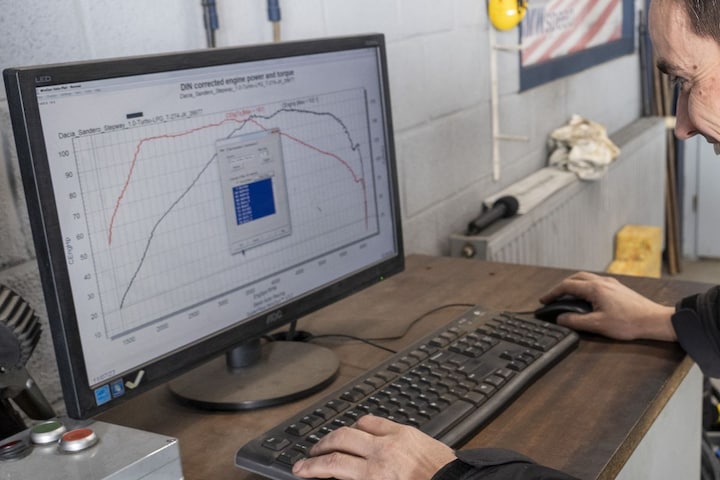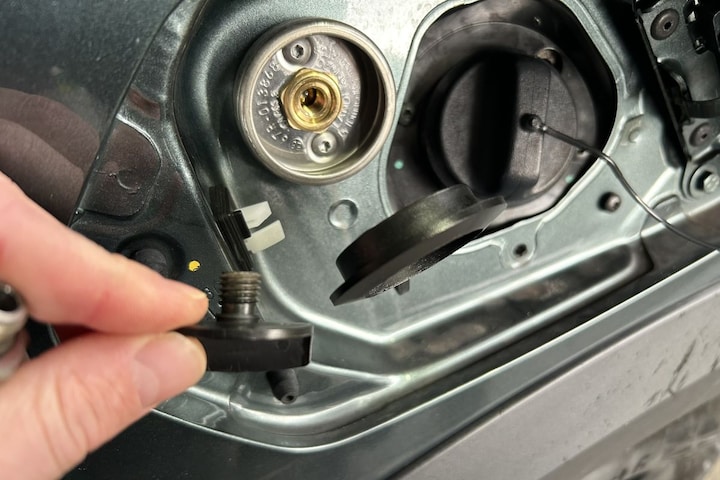And refueling keeps smiling

The Dacia Sandero Stepway is already well into its endurance test period. So it’s time to catch up (this has already happened several times in the magazine). We do this using a dynamometer measurement and we noticed some ailments in the cold. This is how it works now with the Sandero Stepway TCe 100 Bi-Fuel, on LPG.
When happiness was still very common, a car running on LPG always produced less power than when the engine ran on petrol. Not very complicated: the energy value of LPG is slightly less than petrol. It ‘burns’ slightly less well, so produces less output. It was therefore just as logical that the fuel consumption of a car that ran on LPG was less favorable than when the car ran on petrol. These certainties can partly be thrown in the trash. The men from Dacia have taken a different approach. Their Sandero Stepway delivers a nice round 100 hp (74 kW) maximum power, but does so on LPG. On petrol the car produces 67 kW, so 90 hp. The same goes for the top speed. That is 174 km/h on LPG and 173 on petrol. Special.
Another point for improvement that Dacia claims: the maintenance costs of the Eco-G models are the same as those of the petrol models, despite more ‘stuff’ on board.

The three-cylinder engine with turbo.
Higher consumption on LPG
Another obvious fact remains: the Sandero has a seriously higher consumption on LPG compared to petrol: 1 in 14 on LPG compared to 1 in 17.2 on petrol, according to the factory. But … the CO2 emissions on LPG are still lower: 114 versus 130 grams.
Time to go back to the source: the importer who offers this Dacia Sandero Stepway for sale and lent it to us. A spokesperson for the technical service explains: “LPG potentially has a higher octane number than petrol. We use that higher octane number in the LPG installation of our cars. This requires special coordination of the engine management. Often the engine management settings of the petrol engine are simply maintained, but then you lose power.” So it’s a matter of fine-tuning.
We have the Dacia Sandero Stepway secured at our regular address for power measurements, Beek Auto Racing in The Hague. The used car section On the dynamometer will also be included there.

Owner and chassis dynamometer manager Ghisbert van Ginhoven: “With LPG systems that are retrofitted, you always see some loss of power, but with installations that are installed at the factory, a nice property of LPG is used during the adjustment, namely its knock resistance. That’s very good. The engine management has also been worked on in this Dacia, because this difference with petrol of plus 10 hp is on the high side.”

Take a look at the curves in the graph! Our endurance test Sandero Stepway is the best boy in the class. Neatly according to what the manufacturer specifies, the Dacia peaks at 101.5 hp on LPG, while on petrol it is 10 hp less. The torque curve shows approximately the same difference, the pulling power on petrol lags behind by about 25 Nm.
Power and torque are now fixed once and for all. Now we are going to check the consumption on petrol alone, because so far we have still managed to find an LPG pump, here at home and abroad.
And what happens with the Dacia as an endurance tester?
Perhaps it is due to the unusually cold January period, but our endurance test Sandero is starting to show a number of ailments that we were previously unaware of from our sympathetic crack rider.
“Schraaaaaaaaaaaap” is heard somewhere from the chassis of the Dacia Sandero endurance tester, but only under specific circumstances. Those are always the most annoying problems. First you have to figure out when you hear something and only then can you focus on what exactly you hear. Fortunately this time it isn’t too bad. After fifteen minutes it is quite clear that the scraping sound can only be heard when you turn right and it sounds like something is approaching, so the rear right is the most logical side.

And indeed, a plastic mudguard in the rear right wheel arch appears to be a bit out of context. Straight-line it does not touch the tread of the tire, but if the car turns to the right (and the right rear wheel drops slightly in relation to the carriage) the parts do touch each other. The strange thing is that it is not entirely clear how exactly it happened. With some appropriate force, the plastic plate can be pulled back into shape and we have not heard anything since. Maybe it was the freezing cold of January.

This is how the flap should sit.
The Dacia has not shown its most sophisticated side in recent times. We hear some rattling from the left front door, the demisting process takes a very long time at times and the screw that secures the LPG fuel cap recently fell to the ground spontaneously while refueling, while previously it had always remained neatly hanging. We also pushed that back and it has been going well since then. Perhaps the screw has never been tightened and has simply remained stuck on the thread until now.

Finally, we notice that it takes considerably longer for the Sandero to switch to LPG after the cold start. Where this used to take at most half a minute, you now sometimes drive on petrol for a few minutes before the familiar click lets you know that the three-cylinder engine continues on gas.
Tanken keeps smiling
That also means that we actually had to fill up with gas once. Or well, it wasn’t necessary yet, but we were at the pump anyway, so we threw in 11 liters for the occasion. This means that the petrol consumption is currently 1 in 1,078, so that is quite nice. Naturally, gas consumption is a bit higher, but that is also manageable in cold conditions. We now score about 1 in 12 per tank. Our average is still 1 to 13.9 and with a liter price that consistently remains below the euro, refueling is of course still fun. And who knows, the Sandero might soon feel better again in warmer weather.
Dacia Sandero Stepway Eco-G in numbers
Starting score 2,385
Score 14,251
Kilometers driven: 11,866
Liters of LPG refueled 852.81 l
Liters of petrol filled 11.0 l
Average consumption LPG 7.2 l/100 km (1: 13.9)
Average petrol consumption 0.09 l/100 km (1: 1,078.7)
Fuel costs €753.52
– Thanks for information from Autoweek.nl